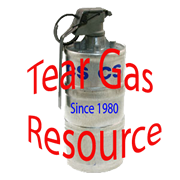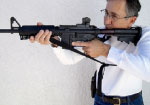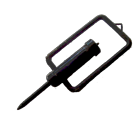Do we need to spend money to increase the accuracy of our grenadiers on a call out? How often do we miss our target (window)? Do we alert the suspect if we shoot and miss? If the suspect is alerted can he now prepare physically and psychologically for the insertion of a non-lethal chemical agent? Will this make it more dangerous for any follow-on tactics? The answer to these questions is YES.
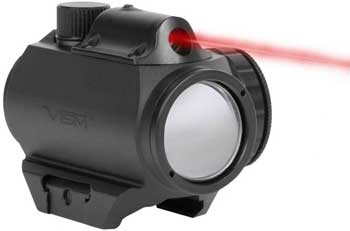 The Grenadier with a laser aiming or reflex sight in conjunction with a chemical agent launcher dramatically increases his shooting speed and accuracy especially if he is wearing a respirator.
The Grenadier with a laser aiming or reflex sight in conjunction with a chemical agent launcher dramatically increases his shooting speed and accuracy especially if he is wearing a respirator.
Some additional observations of the use of laser or reflex sights:
Increase first round accuracy: In any tactical situation when you are on the move or behind cover, first round accuracy may spell the difference between life and death. A miss can alert the suspect to your position and allow him to prepare mentally or physically for the introduction of tear gas. Laser sighting devices help ensure that the first round fired hits the target.
Better shooting accuracy from different positions: In a tactical deployment you may not always be able to assume an ideal shooting position. An aiming laser can be used to accurately aim a launcher even if the Grenadier is unable to visually index the iron sight. For example, an officer can use an aiming laser from behind a ballistic barricade to accurately aim his launcher. Lasers can also greatly assist in aiming a launcher while running or even when traveling in a BearCat or other 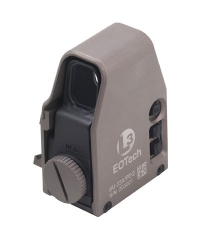 armored vehicle.
armored vehicle.
Psychological Deterrent: An aiming laser can provide a clear psychological advantage over a barricaded suspect. If put into the position of confronting the suspect when you are armed with your projectile launcher and you have targeted a suspect with a laser point, there is no longer any question, in the mind of the suspect as to what will likely happen if the you are required to pull the trigger. Several police agencies have reported that laser aiming devices clearly added an additional less-than-lethal force alternative. In moments of tension and high stress, an officer’s verbal commands to a suspect at gunpoint often go unanswered. These are critical moments when you must make split second, life or death decisions. The visual impact of the red laser dot has assisted officers in gaining compliance quickly. Kevin Stich of the Newberg Police Department, Oregon, said in an edition of Law Enforcement Technology, “[In one case] pointing the laser dot on a suspect convinced him to give up, where verbal commands didn’t work.” In our view, if employing an aiming laser will improve the likelihood of ending a stand-off without having to fire a shot, then it may be worth employing as part of your law enforcement threat continuum.
Improved Situational Awareness: Situational awareness is a key to officer survival. In a high stress encounter, people have a tendency to focus all of their attention on the perceived threat and disregard other risks or features that may be present. This target fixation can be compounded when looking through an iron sight or an optical scope on the weapon. An aiming laser may help avoid target fixation as it allows the user, once the target is acquired, to look up from the iron sight and view the situation in its entirety while retaining confidence that you have retained an accurate bead on his target. This allows your brain time to subconsciously plan your future shots at those other targets. The improved situational awareness may reduce the risk of hitting a fellow team member who accidentally crosses the line of fire, and it will improve the officer’s ability to respond to an unexpected threat from the suspect.
Shortcomings of a Laser Sight:A laser dot is extremely difficult and sometimes impossible to see in bright sunlight during the middle of the day. This is especially true when the sun is shining directly on a white or brown or red object. On a bright sunny day if you can't see your laser dot on the target then you need to be prepared to fire using your front sight. Your laser batteries may expire at a time of critical need. Therefore you should continue to practice without your laser sight each time you practice with your laser sight. This will enable you to remain reasonably proficient with and without a laser sight. Laser sights are relatively expensive. A rail mounted laser sight will usually cost somewhere between $350 to $500(more or less).
Alternatives to the Laser Sight:The AimPoint sight is versatile and can be an alternative for a laser. It is quick to site your target but limits your peripheral vision more than a laser. 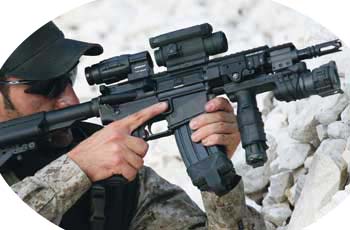 Elite police and military forces around the world have used Aimpoint red dot sights for more than 20 years to increase speed and accuracy. Aimpoint red dot sights are rugged, water proof and withstand any weather conditions. And with battery life measured in years, reliability is never an issue.
Elite police and military forces around the world have used Aimpoint red dot sights for more than 20 years to increase speed and accuracy. Aimpoint red dot sights are rugged, water proof and withstand any weather conditions. And with battery life measured in years, reliability is never an issue.
With an Aimpoint sight the visible dot remains parallel to the bore of your weapon no matter what angle your eye is in relation to the sight. This means you never have to worry about centering the dot inside the sight. When the dot is on target, so are you. You will be able to get on target fast, and can forget about being challenged by bad light or a bad position.
Aimpoint sights work in all light conditions from the darkness to bright sunlight. Lasers are hard to see in the bright daylight. They are fully submersible so you never have to worry about rain or immersion.
Trijicon SRS™ Reflex Sight. The Trijicon SRS (Sealed Reflex Sight) is a reflex-type sight with a unique optical design, housed in a body length of only 3.75 inches that virtually eliminates the “tube-effect” common with other, red dot sights. The result is a field of view that essentially provides no obstruction to shooters. That means lightning fast target engagements with no distraction from the shooter’s situational awareness The SRS is powered by a solar panel and a single, common AA battery. This uniquely patented configuration allows the user years of illumination life from a single battery by offering an intuitive “solar assist”, that is, drawing on battery power only when the solar cell requires additional energy support for illumination based on ambient conditions.
Additional reading: Of Lights and Lasers
